The bluegill is the most common and widely known species in the sunfish family. Andy Morrison / Adobe stock
Bluegills are beloved by anglers across North America. Many of us—this author included—got our start catching them in farm ponds and creeks, and bluegills can be found in every U.S. state outside of Alaska. Because of their popularity and prevalence, many people lump bluegills in with other sunfish. (Anglers are also guilty of this.) They’ll use these names interchangeably, referring to any sunfish as a bluegill when it might actually be a longear, a redbreast, or some other member of the sunfish family. To avoid this confusion, we’ve compiled a guide that compares sunfish vs bluegill and offers some tips on how to correctly identify them all.
Why the Confusion?
The confusion between sunfish vs bluegill stems from the fact that every bluegill is a sunfish, but not every sunfish is a bluegill. In other words, the term “bluegill” refers to one species, while “sunfish” refers to a family of more than 30 different freshwater species that are native to North America.
Overview of the Sunfish Family
The sunfish family (Centrarchidae) comprises eight different genera or branches. The majority of anglers will be most familiar with the last three of these branches as they include several popular game fish species:
- Sacramento perch (Archoplites)*
- Mud sunfish (Acantharchus)*
- Flier (Centrarchus)*
- Banded sunfish (Enneacanthus): Banded, blackbanded, and blue-spotted sunfish
- Rock bass (Amblopites): Rock bass, shadow bass, Roanoke bass, and Ozark bass
- Crappies (Pomoxis): White crappies and black crappies
- Black bass (Micropterus): 13 species, including smallmouth and largemouth bass
- True sunfish (Lepomis): 13 species, including bluegills, warmouth, and green sunfish
* This genus only has one species.
This article will focus strictly on the true sunfish genus. Many of these species look alike, and this is where most of the confusion occurs when looking at sunfish vs bluegill.
Read Next: The Best Fishing Reels
All true sunfish have a rounded body shape and small mouths, and most species average between three and eight inches long. These small fish are often referred to colloquially as bream or perch, although the latter is actually a misnomer. (Perch belong to a separate family of North American freshwater fish.
All About Bluegill
Of the 13 true sunfish that inhabit North America, the bluegill (Lepomis macrochirus) is the most abundant, widespread, and commonly caught species. This is why they are so well-known among American anglers, and it’s why people often use bluegill as a catch-all term for several different sunfish species.
Appearance
Like all the other true sunfish, bluegills have rounded, dish-shaped bodies, small mouths, and spiny dorsal fins. The name bluegill derives from the iridescent bluish coloration on the cheek and gill plate. They also have a black earflap, which is one way to distinguish bluegills from other true sunfish species.
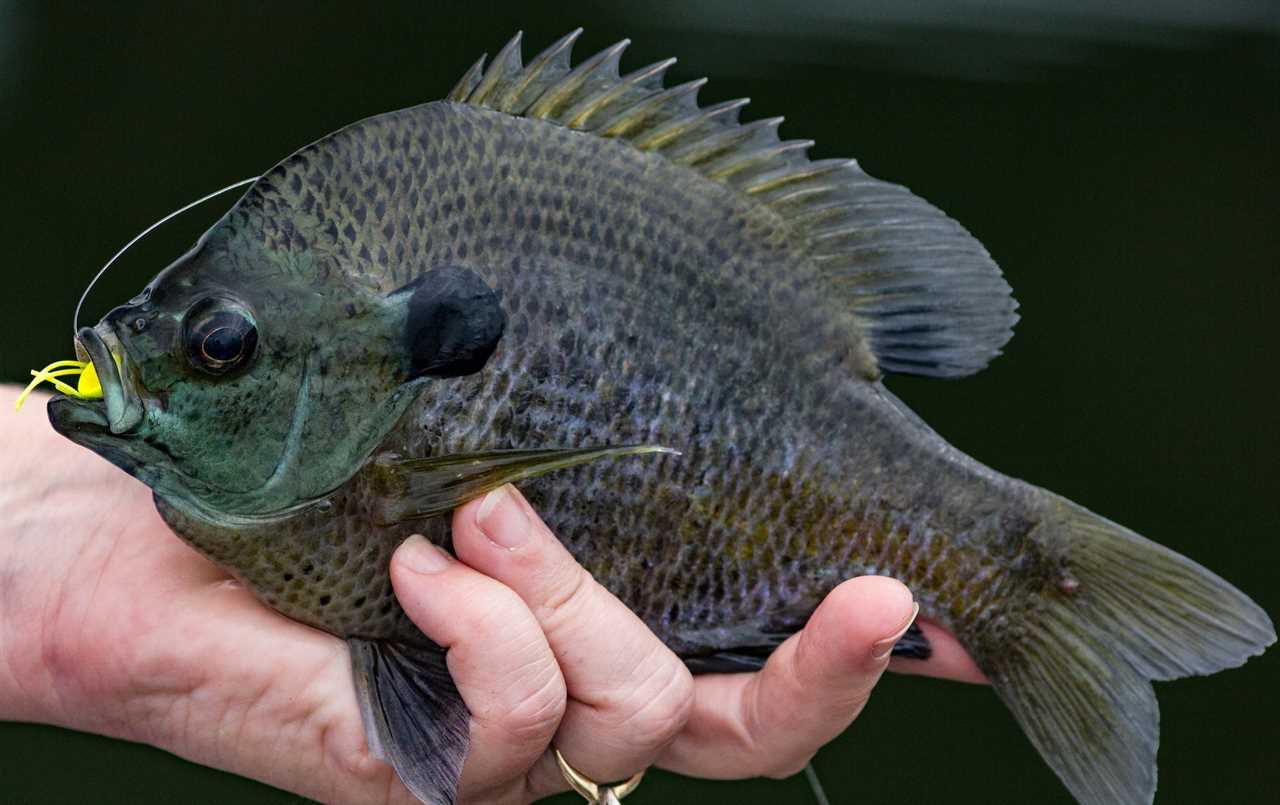
A fly-caught bluegill. Notice the bluish cheek, dark earflap, and the dark spot at the base of the dorsal fin. Steve Dally / Adobe stock
Bluegills can vary slightly in color depending on the location and time of year. (Spawning males display brighter, more intense colors, for example.) But they generally have olive backs, copper-orange sides with vertical bars, and reddish-orange or yellow bellies. Their dorsal fins have nine to 12 spines. These spiny fins are connected to softer, rounded dorsal fins that extend almost all the way to their tailfin and have a dark spot at the base.
An adult bluegill has an average length of around seven inches, but due to their oval body shape, these fish can be nearly as tall as they are long. They average around one to two pounds, with the largest individuals growing to more than twice that size. The all-tackle world record bluegill weighed 4 pounds, 12 ounces and was caught from Ketona Lake in Alabama in 1950.
Distribution and Habitat
Bluegills historically occupied a native range that covered most of the Eastern and Central United States. This included the St. Lawrence-Great Lakes and Mississippi River Basins—stretching from Quebec and New York to Minnesota and then south to the Gulf of Mexico—as well as the entire southeast region from Virginia’s Cape Fear River to the Rio Grande in Texas and New Mexico.
Because they’re relatively easy and fun to catch, bluegills have been introduced in every U.S. state except Alaska. Most of these stockings were done by state fish and game agencies. The species has also been introduced to various countries in Europe, Africa, Asia, and South America.
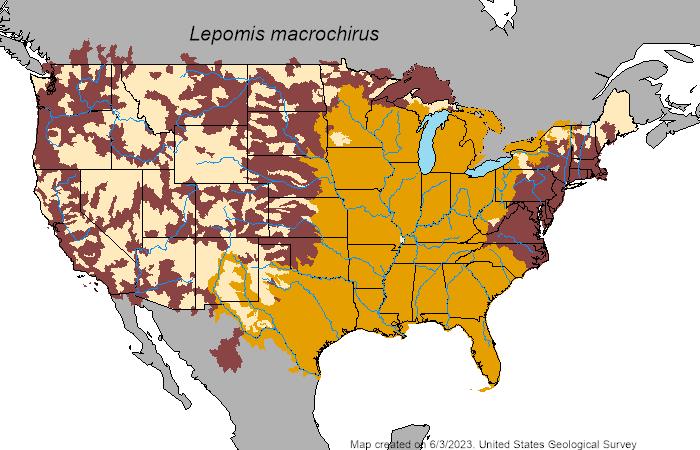
Bluegill can be found in 49 U.S. states. The yellow shading represents the native range of bluegills, while the red areas show the areas where they’ve been introduced. USGS
Bluegills are a warm-water species and they require water temperatures between 60 and 80 degrees F. While they can tolerate low levels of salinity, they are most at home in freshwater ponds and lakes, as well as slow-moving rivers and creeks.
Read Next: 10 Tips for Catching Giant Bluegills This Summer
They prefer areas with lots of aquatic vegetation, and are often found near logs, weed beds, or some other structure (both natural and manmade). Bluegills typically inhabit deeper water, where they tend to congregate in schools. They’re also territorial, and will typically stay within a 300 to 400 square foot area for most of their lives.
Behavior and Habits
Bluegills are voracious and opportunistic carnivores. Their diet consists primarily of insects, tiny crustaceans, zooplankton, and other small prey items. They’ll also prey on leeches and worms, along with minnows and other small baitfish. Bluegills typically feed during daylight hours, and they often move closer to the surface to eat bugs during the mornings and evenings.

Bluegills often congregate near downed trees and other structure, where they can easily hide from predators. Caleb / Adobe stock
Bluegills are also prey to countless larger freshwater species, and they spend most of their lives dodging predators. Bass, muskies, walleyes, and catfish all love to eat bluegills, as do snakes, turtles, herons, and other waterbirds. This is where their spiny dorsal fins come in handy—by extending these spines, they’re harder (and more painful) to swallow.
Adult bluegills spawn in the spring. They build nests for spawning, and will typically nest together in large colonies in shallow water.
Read Next: The Best Fishing Kayaks
The males build nests by sweeping circular depressions in the lake or stream bed with their tail fins. They’ll swim around these nests to attract females. Once a female’s eggs are released and fertilized, the male is left to guard the nest. After two to five days, the eggs hatch into fry, which are then guarded by the males for another five to 10 days until the fry begin feeding on zooplankton and swim away on their own.
How to Identify Bluegill and Other Common Sunfish Species
It can be difficult to correctly identify each of the 13 true sunfish species. To the untrained eye, they all look very similar. These species also hybridize, which makes identification even more challenging.
Read Next: Meet the Alabama Angler on a Mission to Grow (and Catch) the Next World-Record Bluegill
Fortunately, there are some distinguishing features and a few visual markers that can help distinguish a bluegill from another common sunfish. The species that are pictured and included in the table below are the ones that are most often mistaken for bluegills:
Pumpkinseed
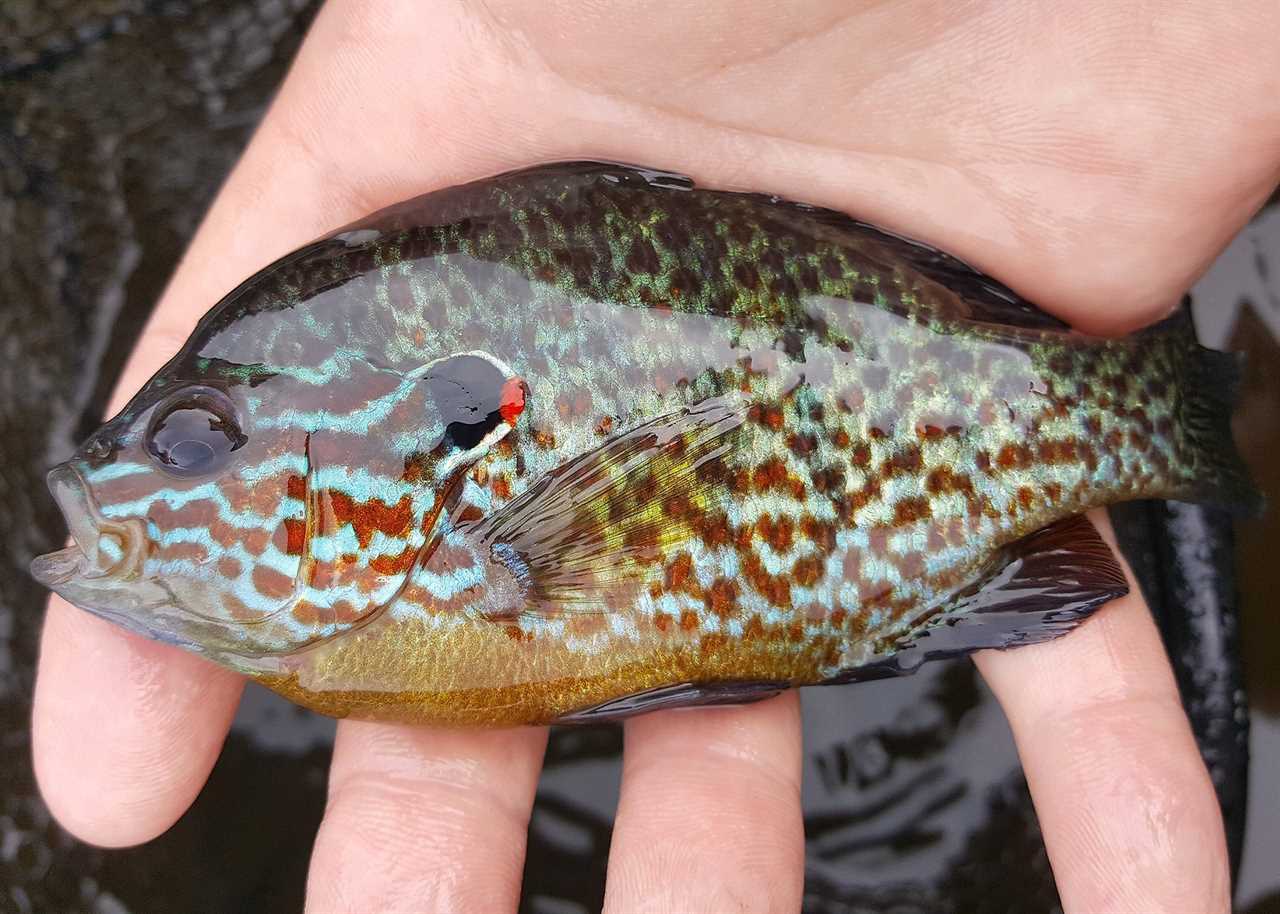
Pumpkinseeds are some of the most brightly colored of the true sunfish. Oregon Department of Fish and Wildlife
Warmouth
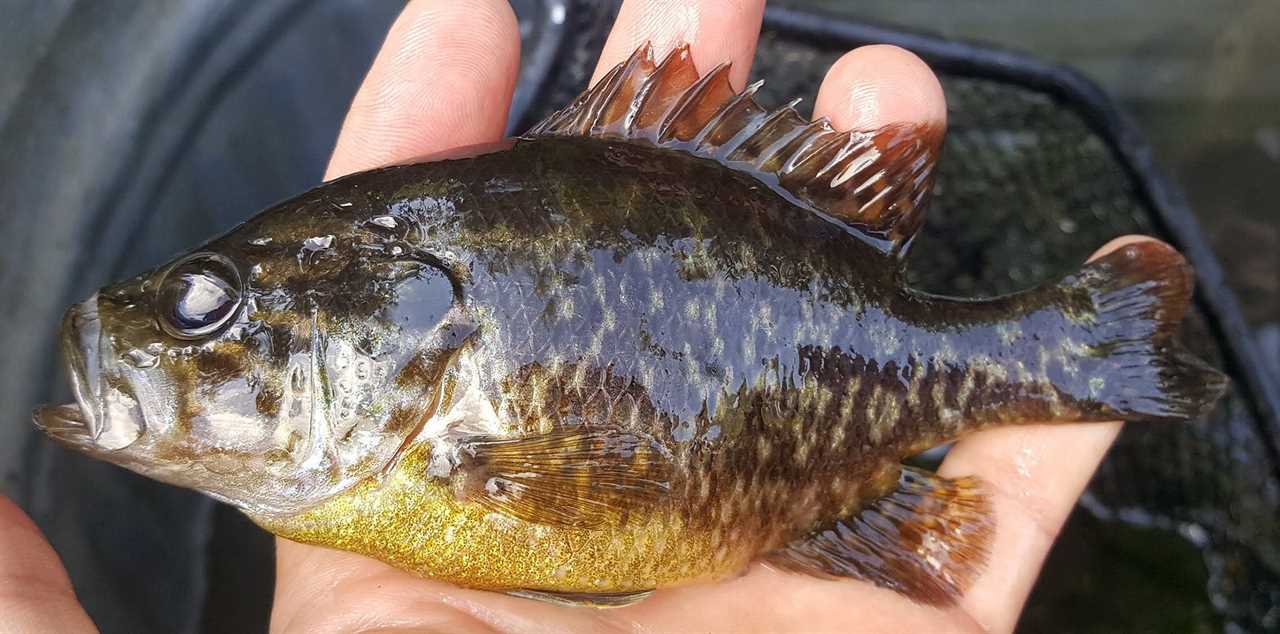
Warmouth have a darker coloration and are sometimes confused with rock bass as well. Oregon Department of Fish and Wildlife
Green Sunfish
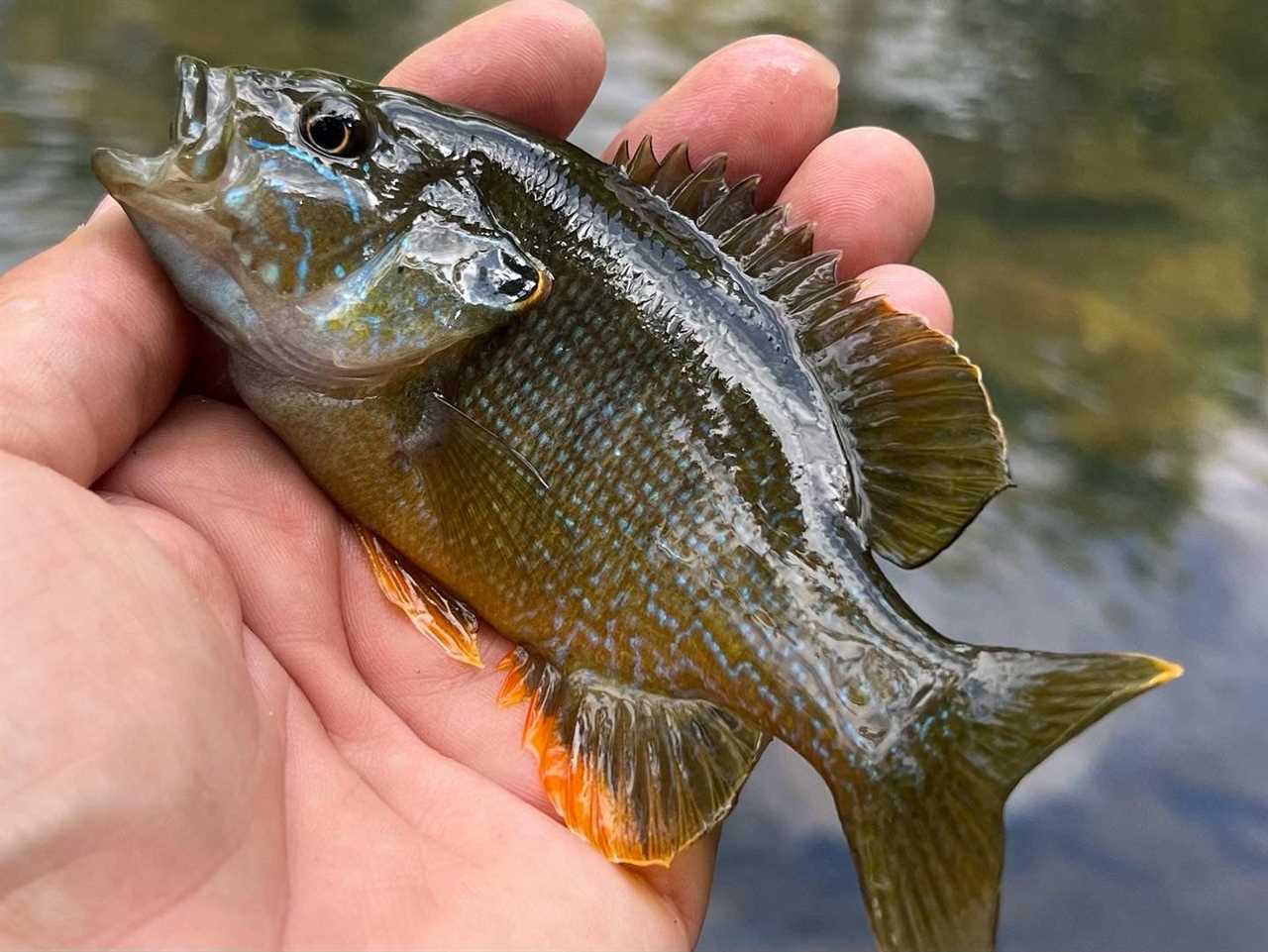
Green sunfish also have bluish cheeks and gill plates, but unlike bluegills, the tips of their pectoral and anal fins are bright orange. Eric Packard / Maryland Fisheries Service DNR
Redear Sunfish
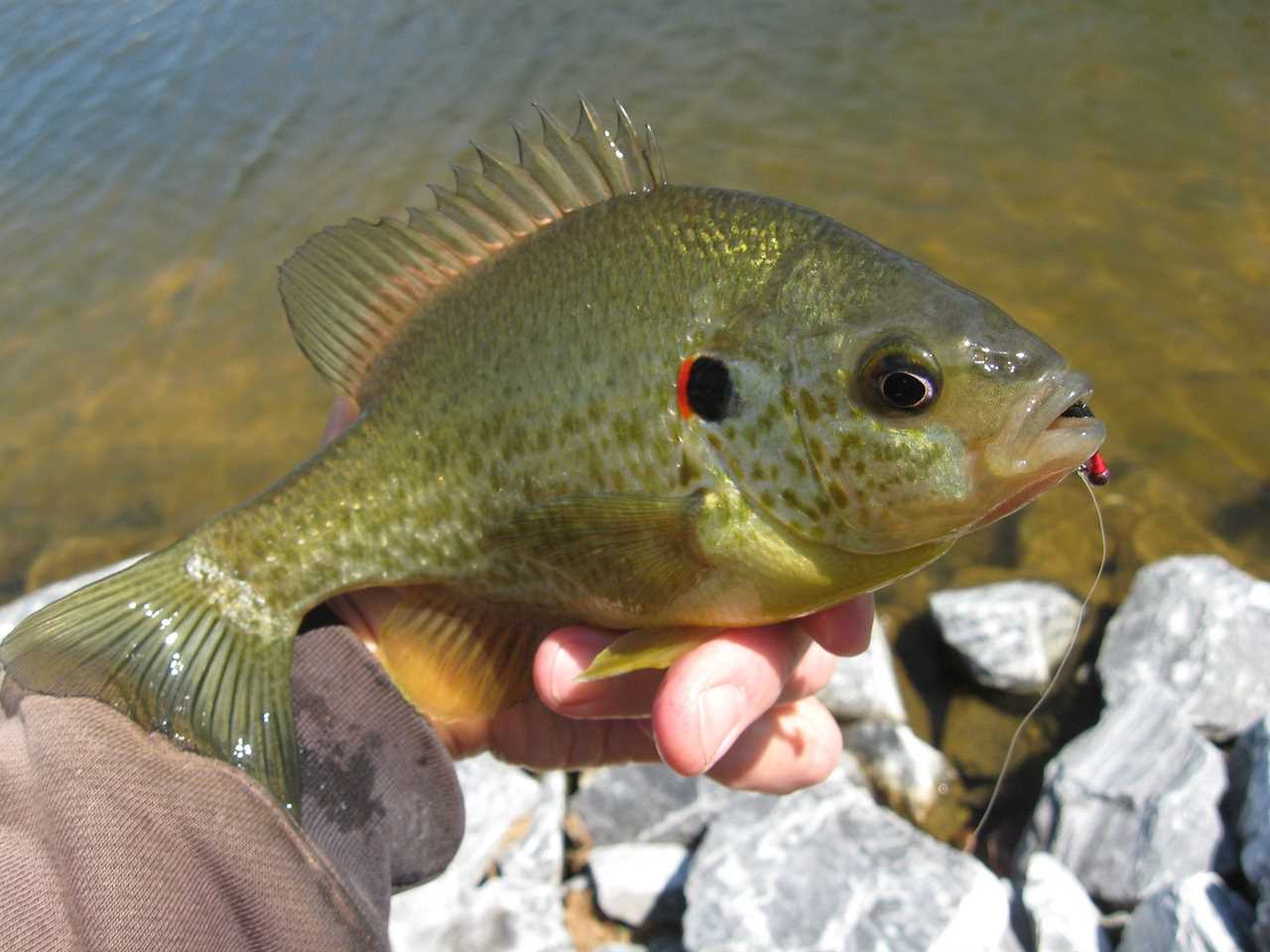
Redear sunfish have a visible red or orange mark on the dark-colored earflap. Jim Gronaw / Maryland Fisheries Service DNR
Longear Sunfish

Longear sunfish have a pronounced earflap that is noticeably longer than most other true sunfish species. Florida Fish and Wildlife
Redbreast Sunfish

Redbreast sunfish look a lot like bluegills, but they typically have brighter colored bellies. They also lack the telltale dark spot at the base of the dorsal fin. David Redden / Maryland Fisheries Service DNR
Here’s a basic chart to help with identification:
| Species Name | Average Size | Coloration | Distinguishing Features |
| Bluegill | 6-9 inches, 1-2 pounds | Dark olive backs, copper sides, yellow-orange bellies, bluish jaws and gill plates | Black earflap; dark spot at base of dorsal fin |
| Pumpkinseed | 3-5 inches, less than 1 pound | A vibrant mixture of green, orange, yellow and blue, with speckles on their sides | Vertical bars are less defined than a bluegill’s; black earflap has an orange-red, crescent-shaped edge |
| Warmouth | 4-8 inches, 1-2 pounds | Dark, mottled brown with golden bellies | Reddish-brown streaks near the eyes; bright orange spot at base of dorsal fin |
| Green Sunfish | 3-5 inches, less than 1 pound | Blue-green back and sides with yellow flecks | Gill plates have blue coloration that is brighter than a bluegill’s; longer snout that extends beneath middle of the eye |
| Redear sunfish | 6-8 inches, 1 pound | Yellow-olive sides with a darker back and faint vertical bars | Red (males) or orange (females) edge is visible on the dark earflap |
| Longear sunfish | 6-8 inches, 1 pound | Olive-brown back with a bright orange belly and blue-green specks | Pronounced, elongated earflap |
| Redbreast | 4-6 inches, less than 1 pound | Olive-green body transitions to a vibrant, red-orange belly | Longer earflap than a bluegill; Reddish-yellow coloring on cheeks and throat; no dark spot at base of dorsal |
The other six true sunfish species are easier to distinguish from bluegills. They’re also less common:
- Spotted sunfish
- Orangespotted sunfish
- Redspotted sunfish
- Northern sunfish
- Bantam sunfish
- Dollar sunfish
Sunfish vs Bluegill FAQs
Q: Are bluegills and sunfish the same thing?
Yes and no. All bluegills are sunfish, but not all sunfish are bluegills. The bluegill is just one of more than 30 freshwater species that comprise the sunfish family. There are six other true sunfish species that are often mistaken for bluegill, and those include the pumpkinseed, warmouth, green sunfish, redear sunfish, longear sunfish, and the redbreast. Hybrid bluegills are possible with these species, which makes identification even trickier.
Q: How large is a bluegill?
An average adult bluegill weighs around one or two pounds, but they can exceed four pounds. The biggest bluegills are roughly the size of a small dinner or salad plate.
Q: Are bluegills good to eat?
Yes. Bluegills are abundant and they make great table fare. They have a white, flaky meat with a mild flavor. They’re often filleted and fried in a skillet, or cleaned, descaled and cooked whole. They’re called panfish not just because of their shape, but because they fit in a frying pan.
Final Thoughts on Sunfish vs Bluegill
Remember that “bluegill” refers to a single species, while “sunfish” refers to an entire family of freshwater fishes. Bluegills are the most common and widely known of all the true sunfish.
To distinguish sunfish vs bluegill, look for the dark earflap and the dark spot at the base of their dorsal fin. This is a bluegill. If the fish has both these physical features, along with a dark olive back, a yellow-orange belly, and a bluish jaw and gill plate, it’s most likely a bluegill or a bluegill hybrid.
The post Sunfish vs Bluegill Identification Guide appeared first on Outdoor Life.
Articles may contain affiliate links which enable us to share in the revenue of any purchases made.
By: Dac Collins
Title: Sunfish vs Bluegill Identification Guide
Sourced From: www.outdoorlife.com/fishing/sunfish-vs-bluegill/
Published Date: Mon, 03 Jul 2023 15:18:59 +0000
----------------------------------------------
 Backyard GrillingWeekend WarriorsAdvice from DadBeard GroomingTV Shows for Guys4x4 Off-Road CarsMens FashionSports NewsAncient Archeology World NewsPrivacy PolicyTerms And Conditions
Backyard GrillingWeekend WarriorsAdvice from DadBeard GroomingTV Shows for Guys4x4 Off-Road CarsMens FashionSports NewsAncient Archeology World NewsPrivacy PolicyTerms And Conditions
